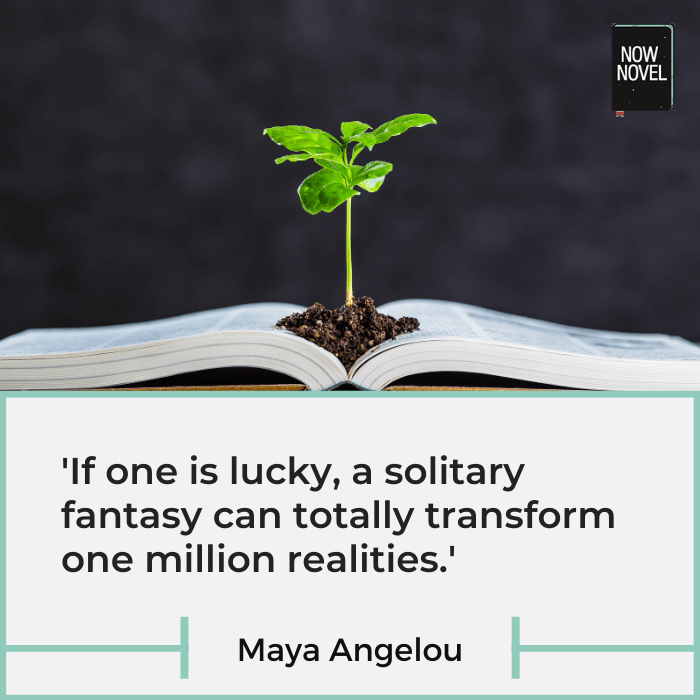The best fantasy series offer many lessons in building magical worlds and fantastical escapades. Read 7 lessons from series by Le Guin, Tolkien, Pratchett, Lewis and others:
1. Create magic with the details
The 'rules' for world building are similar to the rules for writing realism. Details, large and small, help to bring an invention to life.
Fantasy worlds that have attention to detail allow us to imagine a different creature under every rock, a different set of traditions and beliefs in every town.
Examples of detail in the best fantasy series
J.R.R. Tolkien, author of the Lord of the Rings epic fantasy cycle, was a linguist and invented entire languages (including his Elvish languages, Sindarin and Quenya).
J.K. Rowling's academic background in Classics helped her create details for her Harry Potter universe. Such as names for magical phenomena that sound ancient (e.g. the Latin-sounding 'Patronus', a summoned guardian).
In the case of Rowling's Patronuses - summoned guardians that ward off soul-sucking creatures - each character's Patronus takes a different form. The form each Patronus takes has personal, symbolic significance. Details in Rowling's world thus connect to characters' personalities and past experiences, adding depth.
2. Give settings character and mystique
Creating your own fantasy world gives you opportunities to create places as weird, wishful and mysterious as you can imagine.
The best fantasy series are full of places that add mood, atmosphere, wonder and surprise.
For example, the cosy Shire, homeland of the Hobbits, in Tolkien's Lord of the Rings is memorable for its rolling green hills and distinctive, round-doored dwellings.
The mysterious Dark Tower in Stephen King's dark fantasy series of the same name is a fabled building that is the meeting place of all universes.
The best fantasy series create a bewitching sense of place. In C.S. Lewis's The Lion, the Witch and the Wardrobe, one of the protagonists stumbles through a portal to a snowy winter wonderland while hiding in an old wardrobe:
Examples of mystique in fantasy settings
It was almost quite dark in there and she kept her arms stretched out in front of her so as not to bump her face into the back of the wardrobe … Then she noticed that there was something crunching under her feet. "I wonder is that more moth-balls?" she thought, stooping down to feel it with her hands. But instead of feeling the hard, smooth wood of the floor of the wardrobe, she felt something soft and powdery and extremely cold.
C.S. Lewis, The Lion, the Witch and the Wardrobe (1950), p. 4
C.S. Lewis lets us experience through Lucy's senses her first steps into the wintry world of Narnia.
In the next example from the Discworld series, Sir Terry Pratchett creates an intriguing, dramatic room where hourglasses measure the time mortals have left to live in a room owned by Death:
This is the bright candlelit room where the lifetimers are stored - shelf upon shelf of them, squat hourglasses, one for every living person, pouring their fine sand from the future into the past. The accumulated hiss of the falling grains makes the room roar like the sea.
Terry Pratchett, Mort (1987), p. 11
This is the owner of the room, stalking through it with a preoccupied air. His name is Death.
[Brainstorm creative settings in Now Novel's story dashboard in Core Setting, then outline locations, cities and countries in the World Builder.]

3. Explain origins
Many acclaimed fantasy series take place in alternate universes. The archipelago of Earthsea in Ursula K. Le Guin's Earthsea trilogy. The world of Middle Earth in Tolkien's Lord of the Rings cycle or the parallel version of the Old West in King's Dark Tower series.
There are many different ways fantasy authors explain their worlds' origins.
Sir Terry Pratchett and Tolkien often use prologues to give details about how their worlds came to be, or the people who live there.
Many modern fantasy novels eschew prologues and instead weave backstory into the narrative.
In Rowling's Harry Potter series, the reader learns about the magical world of wizardry as the protagonist does. This conveys the full wonder a character raised in an ordinary, human world would feel encountering magical, fantastical places for the first time.
Whether you choose the more epic fantasy route of a prologue or weave your world's origins into the unfolding narrative in the main story, remember to:
- Give readers important origins information necessary to understand key conflicts, dangers or social dynamics
- Share details that show readers what is unique, interesting and surprising about your world
4. Give characters depth
It's easy to think of fantasy characters in terms of tropes. Orphan-who-must-save-the-world. Power-crazed villain.
The best fantasy series teach us that every character should have depth. By depth, we mean they should be three-dimensional, with explicable motivations.
Examples of characters with depth in fantasy
In George R. R. Martin's A Song of Ice and Fire series, the character Cersei Lannister is a member of one of the wealthiest families in Westeros.
Yet Cersei initially has limited power. Marriage is brokered between families. Cersei is nearly forced into exile to spare the lives of her children when her infidelity to her husband (and incestuous relationship) is discovered.
Cersei's lust for power in the Song of Ice and Fire series makes sense, given her refusal to bow to authorities such as family and taboo. The more power she gains, the more she is able to break society's norms and rules according to her own desires. Her quest for power springs from believable sources - her refusal to fit in with what society dictates.
Many of the great fantasy authors give villains as much depth and complexity as the heroes.
Over the course of the later books in J.K. Rowling's Harry Potter series, the reader learns that loathed characters have deeper backstories that humanize and explain their choices, giving fuller context.
In great fantasy books, characters are more than tropes such as 'warrior', 'magician', 'strong man' or 'chosen orphan'. They have layers of motivation, fears, desires, a history of cause and effect underlying their actions.

5. Make stakes high
Great fantasy series often involve important quests with high stakes.
The objective of a character's quest might be maintaining peace. For example, the quest to destroy the One Ring in The Lord of the Rings has high stakes. The antagonist Sauron seeks world domination, and the ring would help him acquire the power necessary to achieve it.
In the Earthsea series, the protagonist accidentally releases a shadow into the world that threatens him and the natural order after a spell goes awry.
Stakes in the best fantasy series vary. Sometimes they're environmental (a risk to habitat, such as the White Witch's spell that plunges Narnia into eternal winter in The Lion, The Witch). Sometimes they're political (the ascendance of a cruel tyrant to power).
Whatever is at stake, whatever 'failure' means for your characters, make sure stakes are high enough to drive your characters to persevere through adverse situations.
6. Have primary and secondary conflicts
As in other genres, many fantasy stories by masters of the genre involve multiple scales of conflict. The entire series may progress towards a final confrontation with an arch-villain, yet there are minor skirmishes along the way.
They serve multiple purposes. they keep tension, suspense and mystery alive even when the main villain is out of the picture. They provide obstacles along characters' journeys that make their final objectives seem less certain, attainable.
Examples of primary and secondary conflicts
The Lion, the Witch and the Wardrobe:
- Primary conflict: The lion Aslan and the Pevensie children versus the White Witch
- Secondary conflicts: Edmund Pevensie and his siblings (Edmund betrays his siblings to the witch)
The Lord of the Rings:
- The hobbits of the Shire versus the power-seeking tyrant Sauron
- The same versus the Nazgul (undead beings sent to do Sauron's bidding); The hobbits versus members of their party who are corrupted by the One Ring's power
Secondary conflicts may test characters' loyalties, bravery, resolve. They may help them acquire new knowledge, skills and understanding of the tasks ahead.
7. Create limits and tension with rules
Rules are another common element to many of the best fantasy series. Rules for how magic works, who can use it, when, why, and to what extent, for example.
Or rules may govern who may ascend the throne should the reigning monarch die, a common type of rule in fantasy worlds based on the social structures of the Middle Agesm such as George R. R. Martin's Westeros.
Rules are a great source of tension, mystery and plot twists. For example, when Ged uses magic for the wrong reason in the Earthsea series, his abuse of it summons a dangerous shadow that wishes to possess him.
Think about rules such as:
- Who may attain power and how?
- How does transportation work (including portals that enable characters to move between worlds)?
- What do characters require to master systems such as magic, the feudal system?
Get help developing and expanding your fantasy story. Get feedback from peers or one-on-one guidance from an experienced writing coach.








